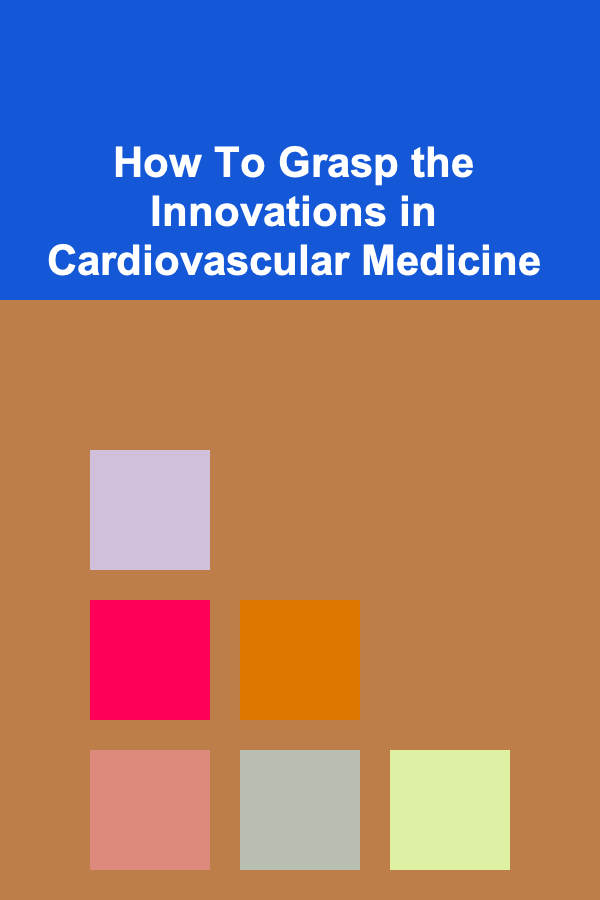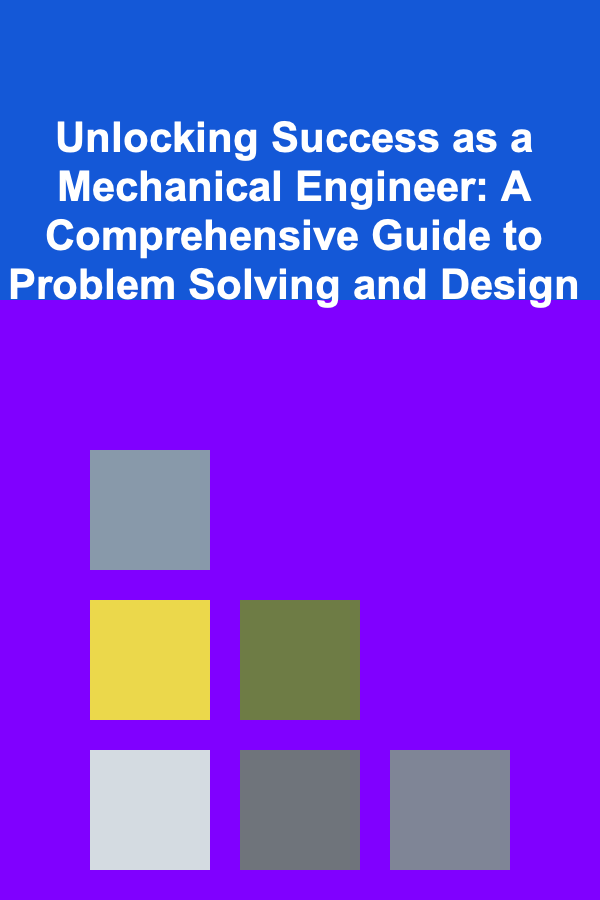
How To Grasp the Innovations in Cardiovascular Medicine
ebook include PDF & Audio bundle (Micro Guide)
$12.99$10.99
Limited Time Offer! Order within the next:

Cardiovascular disease (CVD) remains one of the leading causes of death worldwide. According to the World Health Organization (WHO), heart disease and stroke account for an alarming proportion of global deaths each year. As such, the continuous evolution of cardiovascular medicine plays a crucial role in reducing mortality and improving the quality of life for millions of people around the world.
To truly understand the innovations shaping cardiovascular medicine today, it is important to look at how these advancements are revolutionizing prevention, diagnosis, treatment, and rehabilitation. From breakthroughs in genomics to cutting-edge technologies like artificial intelligence (AI), the medical landscape is witnessing rapid progress. In this article, we will explore the key innovations in cardiovascular medicine and provide a roadmap for those who wish to grasp the complexities and opportunities within this field.
The Role of Genomics in Cardiovascular Medicine
The advent of genomic medicine has brought about a paradigm shift in the understanding and treatment of cardiovascular diseases. Genetics and genomics have revealed valuable insights into the molecular mechanisms underlying heart diseases, such as coronary artery disease, heart failure, and arrhythmias.
Personalized Medicine
Genomic data has paved the way for personalized or precision medicine, a practice that tailors treatment based on an individual's genetic profile. One of the key areas where genomics is making a difference is in identifying genetic markers for inherited cardiovascular diseases. For example, familial hypercholesterolemia (FH) is a genetic condition that leads to high cholesterol levels, predisposing individuals to early cardiovascular events. Through genetic testing, physicians can identify individuals at risk and initiate early interventions to prevent disease progression.
Moreover, advances in pharmacogenomics---the study of how genetic variations influence drug responses---are improving the efficacy of cardiovascular treatments. The use of statins, which are commonly prescribed for lowering cholesterol, can vary significantly depending on a person's genetic makeup. By understanding these variations, doctors can prescribe the most effective statin for each patient, optimizing outcomes and reducing side effects.
Gene Therapy
Gene therapy represents another cutting-edge frontier in cardiovascular medicine. This involves introducing, removing, or altering genetic material within a patient's cells to treat disease. In cardiovascular medicine, gene therapy is being explored to address conditions like heart failure, where damaged heart muscle is unable to pump blood effectively. Researchers are investigating ways to deliver genes that could potentially regenerate heart tissue or stimulate the growth of new blood vessels, offering hope for patients with chronic heart conditions that were once considered untreatable.
Artificial Intelligence and Machine Learning in Cardiovascular Medicine
Artificial intelligence (AI) and machine learning (ML) are changing the landscape of cardiovascular healthcare, offering innovative solutions for early detection, diagnosis, treatment planning, and risk prediction.
Early Detection and Diagnosis
One of the most impactful applications of AI in cardiovascular medicine is in the early detection and diagnosis of heart disease. AI algorithms, particularly those powered by deep learning, can analyze medical images---such as echocardiograms, CT scans, and MRIs---more quickly and accurately than traditional methods. These algorithms are trained to detect abnormalities such as coronary artery blockages, valvular diseases, and early signs of heart failure.
AI-powered tools are also improving the accuracy of risk assessments for cardiovascular diseases. By integrating data from various sources, including electronic health records, genetic data, and lifestyle factors, AI systems can provide highly personalized risk predictions for patients, enabling doctors to intervene early and prevent the onset of disease.
Treatment Optimization
Machine learning algorithms are being used to optimize treatment plans for cardiovascular patients. These systems can analyze large datasets from clinical trials and real-world evidence to identify the most effective treatments for specific patient profiles. For instance, AI is being utilized to predict how patients will respond to certain drugs, enabling doctors to select the best therapy for managing conditions like heart failure, atrial fibrillation, or hypertension.
Additionally, AI is playing a role in the development of robotic-assisted surgery, which allows for more precise and less invasive interventions. Robots, guided by AI, are now being used for coronary artery bypass surgeries and valve repairs, reducing recovery times and improving patient outcomes.
Minimally Invasive Procedures and Catheter-Based Interventions
Minimally invasive procedures have become a cornerstone of modern cardiovascular medicine. These techniques, which require only small incisions or no incisions at all, offer patients faster recovery times, less pain, and lower risk of complications compared to traditional open-heart surgery. One of the most significant innovations in this area is catheter-based interventions.
Angioplasty and Stenting
Angioplasty, a procedure used to open up blocked or narrowed coronary arteries, is one of the most common minimally invasive treatments for coronary artery disease. Using a catheter, doctors can insert a balloon into the artery and inflate it to widen the blocked section. In many cases, a stent (a small mesh tube) is also placed to keep the artery open and prevent further blockage.
Transcatheter Valve Repair and Replacement
For patients with heart valve diseases, particularly those with aortic stenosis, traditional open-heart surgery may not be an option due to age or other medical conditions. Transcatheter aortic valve replacement (TAVR) has emerged as a less invasive alternative. During this procedure, a catheter is used to insert a new valve into the heart without the need for open surgery. TAVR has revolutionized the treatment of valve disease and has significantly improved survival rates for high-risk patients.
Left Atrial Appendage Closure
Another promising minimally invasive procedure is left atrial appendage (LAA) closure for patients with atrial fibrillation (AFib), a condition that increases the risk of stroke. The LAA is a small pouch in the left atrium of the heart where blood clots tend to form in people with AFib. By closing off this appendage using a catheter, doctors can reduce the risk of stroke without the need for long-term blood thinners.
Stem Cell Therapy and Regenerative Medicine
Regenerative medicine is an exciting area of cardiovascular innovation, particularly in the field of stem cell therapy. This approach seeks to repair or replace damaged heart tissue using stem cells, which have the ability to regenerate and differentiate into various types of cells, including heart muscle cells.
Cardiac Stem Cell Therapy
In the context of heart disease, stem cells hold the potential to repair damaged heart muscle, particularly in patients with heart failure. Clinical trials are exploring the use of stem cells derived from a patient's own body (autologous stem cells) or from other sources, such as embryonic stem cells, to promote healing in the heart. Although this field is still in its early stages, the promise of stem cell therapy offers hope for patients with heart failure and myocardial infarction (heart attack) that could not be treated with traditional methods.
Tissue Engineering
Tissue engineering is another promising area within regenerative medicine. This involves the creation of artificial tissues or organs by combining cells with biomaterials to create functional heart tissue. Researchers are working on creating heart valves, blood vessels, and even small patches of heart muscle that can be implanted into patients to restore function after heart damage.
Advancements in Cardiovascular Pharmacology
Pharmacology plays a central role in the management of cardiovascular diseases, and ongoing research continues to produce new and more effective medications.
New Antithrombotic Agents
Antithrombotic agents, which prevent the formation of blood clots, are essential for treating conditions like atrial fibrillation, deep vein thrombosis, and pulmonary embolism. New-generation anticoagulants, such as direct oral anticoagulants (DOACs), are offering alternatives to traditional warfarin therapy. These newer medications have fewer dietary restrictions, require less monitoring, and provide more predictable results, making them a valuable tool in managing clotting disorders.
Lipid-Lowering Medications
Statins, which are commonly used to lower cholesterol levels, have been a cornerstone of cardiovascular prevention for decades. However, newer lipid-lowering agents, such as PCSK9 inhibitors, are now being used to treat patients who cannot tolerate statins or who require further cholesterol reduction. These drugs have been shown to significantly lower LDL cholesterol levels, thus reducing the risk of cardiovascular events in high-risk patients.
Anti-Inflammatory Therapies
Emerging evidence suggests that inflammation plays a key role in the development of atherosclerosis and other cardiovascular diseases. As a result, researchers are exploring the potential of anti-inflammatory therapies to complement traditional cardiovascular treatments. For example, drugs like canakinumab, an interleukin-1β inhibitor, have shown promise in reducing inflammation and preventing cardiovascular events, particularly in patients with elevated inflammatory markers.
The Future of Cardiovascular Medicine: Challenges and Opportunities
As we look ahead, there is no doubt that cardiovascular medicine will continue to evolve. However, there are several challenges that must be addressed to fully realize the potential of these innovations. One of the primary challenges is the high cost of new technologies and therapies, which may limit access for many patients. Additionally, there are still many unknowns when it comes to the long-term effects of some of these new treatments, such as gene therapies and stem cell treatments.
Nevertheless, the opportunities for improving cardiovascular care are vast. With ongoing advancements in genomics, AI, regenerative medicine, and pharmacology, the future of cardiovascular medicine holds great promise for improving patient outcomes and reducing the global burden of heart disease.
Conclusion
Grasping the innovations in cardiovascular medicine requires an understanding of the key advancements shaping the field today. From genomics and AI to minimally invasive procedures and regenerative medicine, the landscape of cardiovascular healthcare is rapidly evolving. These innovations offer hope for better prevention, diagnosis, treatment, and rehabilitation, ultimately improving the quality of life for patients worldwide. As the field continues to advance, it is essential for healthcare professionals, researchers, and policymakers to stay abreast of these changes in order to provide the best possible care for patients with cardiovascular disease.

How to Prepare Financially for a Career Change or Job Loss
Read More
How to Use Webinar Hosting to Make Money
Read More
Unlocking Success as a Mechanical Engineer: A Comprehensive Guide to Problem Solving and Design
Read More
How To Understand the Importance of Spaced Repetition
Read More
How To Build Modular Robots for Versatility
Read More
Mastering Photography for Creative Expression
Read MoreOther Products

How to Prepare Financially for a Career Change or Job Loss
Read More
How to Use Webinar Hosting to Make Money
Read More
Unlocking Success as a Mechanical Engineer: A Comprehensive Guide to Problem Solving and Design
Read More
How To Understand the Importance of Spaced Repetition
Read More
How To Build Modular Robots for Versatility
Read More